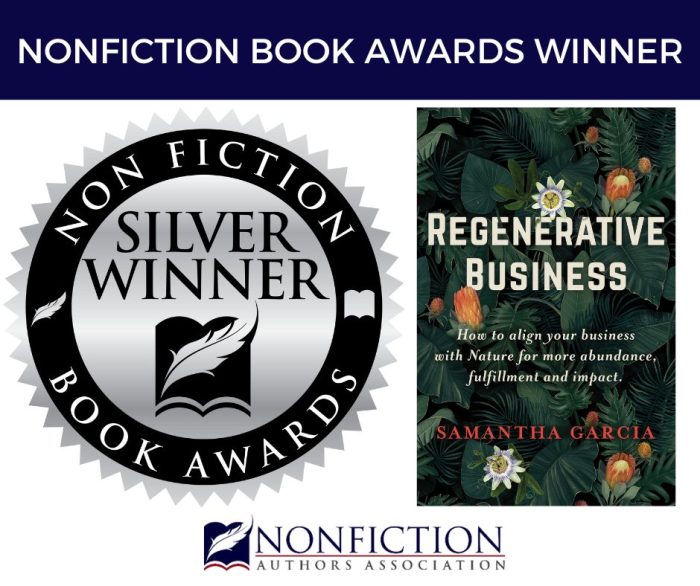Ready to ditch the old-school business model and join the movement that’s making waves? Regenerative business is all about aligning your company with Mother Nature, and it’s not just about saving the planet – it’s about boosting your bottom line, too.
Think of it like this: You’re not just taking from the earth, you’re giving back, creating a win-win for everyone involved.
From sustainable practices to circular economy principles, we’ll explore how regenerative business can help you create a more fulfilling workplace, build a stronger community, and make a real difference in the world. It’s like a super-powered business upgrade, and we’re here to guide you through it.
Understanding Regenerative Business

Regenerative business is more than just a buzzword; it’s a radical shift in how we think about business and its impact on the world. It’s about creating businesses that not only minimize harm but actively contribute to the restoration and renewal of our planet’s ecosystems.
Defining Regenerative Business and its Core Principles
Regenerative business goes beyond simply being sustainable. Sustainable businesses aim to minimize their negative impact on the environment, while regenerative businesses strive to actively improve and restore the natural world. Think of it like this: sustainability is about staying afloat in a leaky boat, while regenerative business is about fixing the leaks and building a better boat.Here are some core principles of regenerative business:
“Regenerative business is about creating a positive impact on the world. It’s about building businesses that are not only good for the environment but also good for people.”
- Restoring Ecosystems:Regenerative businesses prioritize restoring degraded ecosystems and enhancing biodiversity. This could involve planting trees, restoring wetlands, or improving soil health.
- Circular Economy:Regenerative businesses operate within a circular economy, minimizing waste and maximizing resource efficiency. This means using recycled materials, reducing packaging, and designing products for longevity.
- Social Equity:Regenerative businesses are committed to creating a more equitable and just society. They prioritize fair wages, ethical sourcing, and community engagement.
- Holistic Approach:Regenerative businesses take a holistic approach, considering the interconnectedness of social, economic, and environmental systems. They understand that businesses cannot thrive in isolation from the communities and ecosystems they operate within.
Distinguishing Sustainable and Regenerative Practices
Sustainable practices focus on minimizing harm, while regenerative practices aim to actively improve and restore the natural world.
Regenerative business is all about getting back to the basics, you know, like how the folks in the early 1900s in Northeast Washington State lived. Check out The Okanoganeers A Memoir of Early 1900’s Life in Northeast Washington State to see how they worked with nature to survive and thrive.
It’s a reminder that we can do the same today with our businesses, by aligning with the rhythms of nature and creating a more sustainable and fulfilling future for everyone.
| Sustainable Practices | Regenerative Practices | |
|---|---|---|
| Focus | Minimizing negative impact | Restoring and enhancing ecosystems |
| Example | Using energy-efficient appliances | Restoring degraded farmland to support biodiversity |
Examples of Regenerative Businesses
Many businesses are successfully implementing regenerative practices across various industries:
- Patagonia:Known for its commitment to sustainability, Patagonia has gone a step further by investing in regenerative agriculture and supporting organizations working to protect wild places.
- Danone:The global food and beverage company has committed to sourcing 100% of its ingredients from regenerative agriculture by 2030.
- Unilever:This multinational consumer goods company has implemented a “Sustainable Living Plan” that includes goals for regenerative agriculture and water conservation.
Benefits of Adopting a Regenerative Business Model
Businesses that adopt a regenerative business model can experience numerous benefits:
- Enhanced Brand Reputation:Consumers are increasingly demanding ethical and sustainable products, and regenerative businesses are well-positioned to meet this demand.
- Reduced Costs:Regenerative practices can lead to lower costs by reducing waste, increasing resource efficiency, and improving product quality.
- Increased Innovation:The challenge of regenerating ecosystems drives innovation and the development of new technologies and business models.
- Improved Employee Engagement:Regenerative businesses often attract and retain employees who are passionate about making a positive impact.
- Greater Resilience:Regenerative businesses are more resilient to climate change and other environmental challenges because they are actively working to restore and protect natural systems.
Aligning Your Business with Nature

Imagine a business that not only doesn’t harm the environment but actually helps it thrive. That’s the essence of a regenerative business, and it’s not just a feel-good idea, it’s a business model built for long-term success.
Regenerative business is all about tapping into the natural world for inspiration and guidance. It’s about building a business that’s in sync with the planet, not against it. Think of it like Mel Baron’s “Beyond the Dream: A Family Journey Without Limits,” a memoir that shows how embracing challenges and unexpected twists can lead to incredible growth and fulfillment.
Beyond the Dream A Family Journey Without Limits A Memoir by Mel Baron – Just like a family, a regenerative business thrives on resilience, adaptability, and a deep connection to something bigger than itself. And that’s the key to unlocking true abundance and impact.
Identifying Key Areas for Alignment
To align your business with nature, you need to understand the natural cycles and processes that underpin our planet’s health. This means thinking about how your business interacts with the environment in terms of resource use, waste generation, and impact on ecosystems.
Yo, wanna know how to build a business that’s totally down with Mother Earth? Regenerative business is all about aligning your hustle with nature’s flow for a win-win situation. Check out this podcast episode where we dive deep into the good vibes of regenerative business and how it can totally level up your game! Download And Listen Here It’s all about creating a business that’s sustainable, fulfilling, and makes a real impact on the world.
Get ready to ditch the old ways and embrace the future of business that’s good for you and the planet.
- Resource Use:Can you use renewable resources like solar or wind energy? Can you source materials sustainably and minimize waste?
- Waste Generation:Can you reduce, reuse, and recycle waste? Can you turn waste into valuable resources through composting or anaerobic digestion?
- Ecosystem Impact:Can you protect and restore natural habitats? Can you support biodiversity by promoting pollinator-friendly practices?
Reducing Environmental Footprint
Regenerative practices offer a powerful way to reduce your business’s environmental footprint and contribute to a healthier planet.
- Sustainable Agriculture:Using regenerative farming techniques like no-till farming, crop rotation, and cover cropping can improve soil health, increase biodiversity, and reduce greenhouse gas emissions.
- Circular Economy:By adopting circular economy principles, businesses can minimize waste, reuse materials, and keep resources in circulation for longer.
- Renewable Energy:Transitioning to renewable energy sources like solar, wind, and geothermal can significantly reduce carbon emissions and dependence on fossil fuels.
The Role of Circular Economy Principles
The circular economy is a key driver of regenerative business practices. It emphasizes keeping resources in use for as long as possible and minimizing waste generation.
“The circular economy is about closing the loop on materials and energy flows, creating a system where waste is eliminated and resources are used more efficiently.”
Ellen MacArthur Foundation
- Reduce:Minimize the use of resources in the first place by optimizing product design, reducing packaging, and promoting resource efficiency.
- Reuse:Find ways to extend the life of products through repair, refurbishment, and remanufacturing.
- Recycle:Ensure that materials are recycled and reused to create new products.
Stakeholder Engagement
Regenerative business practices require a collaborative approach involving all stakeholders, including employees, customers, suppliers, and local communities.
- Employee Engagement:Empower employees to participate in sustainability initiatives and provide them with the training and resources they need to make a difference.
- Customer Engagement:Communicate your regenerative business practices to customers and highlight the benefits of choosing sustainable products and services.
- Supplier Engagement:Collaborate with suppliers to adopt sustainable practices and source materials responsibly.
- Community Engagement:Engage with local communities to address environmental concerns, support local initiatives, and create a positive impact on the surrounding environment.
Achieving Abundance, Fulfillment, and Impact

Regenerative business is about more than just profits. It’s about creating a world where businesses thrive alongside nature, fostering a sense of abundance, fulfillment, and positive impact for all stakeholders. This approach transforms the workplace into a vibrant ecosystem where employees feel connected, empowered, and inspired to contribute to a greater purpose.
Regenerative business is all about getting back to basics, like how nature works. It’s about understanding the flow of energy and resources, and how to create a system that’s sustainable and abundant. Think of it like studying the human body – you gotta know the anatomy to make a good portrait, right?
Well, artists can learn a lot about the way the body works from the Morpho Fat and Skin Folds Anatomy for Artists (Morpho Anatomy for Artists 4) guide. Just like mastering the human form can lead to incredible art, understanding the natural world can help us create businesses that thrive and give back to the planet.
So, get your thinking caps on and let’s create a future that’s both profitable and planet-friendly!
Measuring the Impact of Regenerative Practices
To truly understand the positive impact of regenerative practices, it’s essential to develop a framework for measuring its effects on your business. This framework can be used to track progress, identify areas for improvement, and demonstrate the value of regenerative business to stakeholders.Here are some key metrics to consider:
- Environmental Impact:Measure reductions in carbon emissions, water usage, and waste generation. Track improvements in soil health, biodiversity, and ecosystem services.
- Social Impact:Evaluate employee satisfaction, engagement, and well-being. Assess the impact on local communities, including job creation, economic development, and social equity.
- Financial Performance:Monitor key financial indicators like revenue, profitability, and return on investment. Track the cost savings associated with regenerative practices, such as reduced energy consumption and waste disposal.
“The true measure of a business’s success is not just its financial performance, but also its impact on the environment and society.”
Paul Hawken
A Case Study: Patagonia’s Commitment to Regenerative Agriculture
Patagonia, a leading outdoor apparel company, has been a pioneer in regenerative business practices. Their commitment to regenerative agriculture extends beyond their own supply chain, advocating for broader adoption within the industry. Patagonia has implemented several initiatives to support regenerative agriculture, including:
- Investing in regenerative farms:Patagonia has partnered with farmers to transition to regenerative practices, providing financial support and technical expertise.
- Promoting regenerative cotton:Patagonia has launched a campaign to promote the use of regenerative cotton, which helps improve soil health and biodiversity.
- Educating consumers:Patagonia has educated consumers about the benefits of regenerative agriculture, raising awareness and driving demand for sustainable products.
These efforts have resulted in tangible benefits for Patagonia and its stakeholders:
- Improved soil health:Regenerative practices have led to healthier soils, which can sequester carbon and improve water retention.
- Increased biodiversity:Regenerative farming practices have supported biodiversity, creating a more resilient agricultural ecosystem.
- Enhanced employee engagement:Patagonia’s commitment to sustainability has attracted and retained employees who share their values.
- Improved brand reputation:Patagonia’s leadership in regenerative business has enhanced its brand reputation and customer loyalty.
Resources and Tools for Businesses Seeking a Regenerative Transition
Transitioning to a regenerative business model can seem daunting, but there are resources and tools available to support businesses along the way.
- The Regenerative Business Alliance:This organization provides a network of businesses, experts, and resources to support the transition to regenerative practices.
- The B Corp Certification:This certification recognizes companies that meet high standards of social and environmental performance, transparency, and accountability.
- The Natural Capital Protocol:This framework helps businesses measure and value their environmental impacts, enabling them to make informed decisions about sustainability.
- The Global Reporting Initiative (GRI):This international framework provides guidance for businesses to report on their sustainability performance.
Summary

Regenerative business is about more than just doing the right thing – it’s about building a future where businesses thrive in harmony with nature. It’s about creating a world where profit and purpose go hand-in-hand. So, if you’re ready to level up your business and make a real impact, join the regenerative revolution.
It’s time to get your business on the right track – for the planet, for your people, and for your profits.
FAQ Explained
What are some specific examples of regenerative business practices?
Examples include using renewable energy sources, reducing waste through composting and recycling, implementing sustainable farming practices, and supporting local communities.
How can I measure the impact of regenerative practices on my business?
You can use metrics like carbon footprint reduction, increased employee satisfaction, and community engagement to measure the impact of your regenerative efforts.
What are some resources available for businesses transitioning to a regenerative model?
There are many resources available, including online communities, consulting firms, and educational programs dedicated to regenerative business practices.

